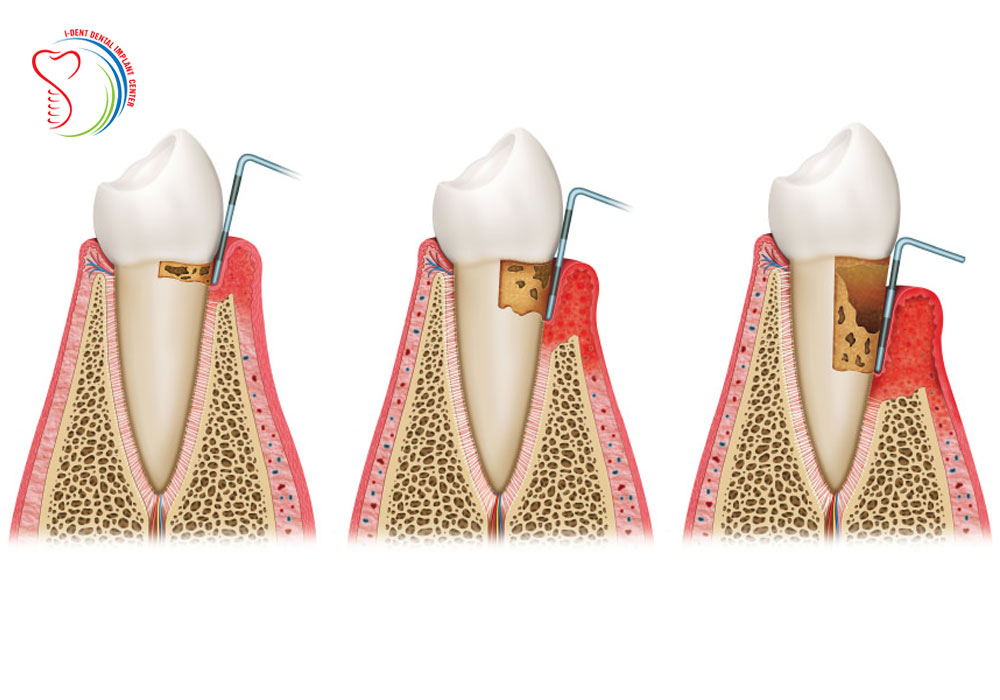Hotline
(+84) 94 18 18 616

Parodontal abscess is an occasional complication arising in periodontal diseases, and less frequently in chronic gingivitis and usually affects only one tooth it is quite distintct from the more often observed periapical abscess and develops within the periodontal ligament at the side of the tooth.
The early acute stages may not shown any change, but after about 10 days an area of rarefaction is observed on one side of the root, and when small it is situated approximately midway between the amelodental junction and apex. If untreated the area becomes larger and involves the whole of the tissues at the side of the root and the root apex.

PATHOGENESIS
The formation of an abscess in general occurs following the localizing effect of inflammation where there is not drainage. A barrier is formed round the area which in the case of an acute abscess consists of chronic inflammatory cells and accompanying fibrous tissue reaction. If drainage is present, the pus does not collect under pressure to form a clinical abscess.
A parodontal abscess probably arises following the spread of infection and destruction of tissue down the side of the root. At first there is drainage, but, as the infection progresses more deeply, adequate drainage is more difficult and a collection of pus occurs under pressure with consequent acute symptoms. The extension of this infection is a slow process but is probably punctuated by acute exacerbation when the equilibrium between the resistance of the patient, the virulence of the microorganisms and the local drainage is disturbed. With an exacerbation there is a localized inflammatory reaction which owing to the swelling, cuts off the drainage. Pus is formed and this may collect to form an abscess.
HISTOPATHOLOGY
In an acute parodontal or periodontal abscess the histological appearance is similar to that described in the acute periapical. In the centre, there is pus containing disintegrated cells and leukocytes, and it is surrounded by a mass of inflammatory cells, the predominant ones being polymorphonuclear leukocytes, though lymphocytes and plasma cells are also present.
In a chronic parodontal or periodontal abscess the microscopic features are similar to the chronic periapical abscess the microscopic features are similar to the chronic periapical abscess. The centre contains pus and this is surrounded by a wall of chronic inflammatory cells, chiefly lymphocytes and plasma cells with a certain number of polymorphonuclear. Occationally macrophages and more rarely multinuclearted giant cells are observed. Adjoining this area is an attempt at organization in which fibroblasts and a few newly formed capillaries are seen. Beyond this is a fibrous tissue capsule which in the early stages of formation contains many cells and is vascular, and later there is reduces cellularity and vascularity. The inflammation may not destroy the cells lining the cementum in the area. The adjoining alveolar bone undergoes resorption.
CLINICAL FEATURES
In an acute periodontal abscess with no drainage there is severe pain which is increased by pressure on the tooth and becomes throbbing in character when lying down. The tooth may be elevated in the socket.
The abscess may discharge in one of two directions. If it is in the uppermost part of the periodontal membrane it will discharge into the pocket or into the gingival tissues where it causes inflammation and swelling. If the abscess is nearer the apical region it will penetrate through the adjoining alveolar bone forming a subperiosteal abscess which may eventually burst through the mucosa forming a sinus through which pus is discharged. When the abscess burst through the alveolar bone and mucosa, the perforation is situated somewhere between the gingival sulcus and the apex, which assists in the different diagnosis from a periapical abscess. Furthermore, the tooth is nearly always vital unless the pulp has died form some other cause, and though the tooth may be sensitive to percussion, neither disease nor pain are such marked feature as in an acute periapical abscess. In nearly all cases there is obvious gingival inflammation.
In the chronic periodontal abscess frequently the only sign is a sinus in the position already described. Sometimes, if the sinus becomes occluded, the abscess may pass through an acute phase with localized swelling and inflammation of the gum. If the sinus has healed over, as frequently occurs, the site is marked a small nodule on the gum.
Note: the efficacy of the treatment can vary depending on each patient’s condition.
For more information please contact:
I-DENT DENTAL IMPLANT CENTER
Dental Clinic - Ho Chi Minh City An Dong
Building 193A-195 Hung Vuong Str, Ward 9, District 5, HCMC
Dental Clinic - Ho Chi Minh City The Army Navy Swimming Pool
Building 19V Nguyen Huu Canh Str, Ward 19, Binh Thanh District, HCMC
Phone: (+84) 28 38 33 68 18
Website: http://www.identdentalimplantcenter.com
Email: identdentalimplantcenter@gmail.com
RELATED: What is the cost of full mounth dental implants in Vietnam, Denal crown done by internation dentist in Vietnam, Dental tourim in Vietnam